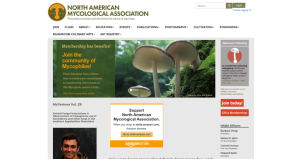 |
February 28, 2020 Volume 26, Number 7 |
General Interest |
Theme: Mycology |
Revisited |
In the News |
General InterestBack to Top | |
 |
|
 |
|
 |
|
 |
|
 |
|
Theme: MycologyBack to Top | |
 |
|
 |
|
 |
|
 |
|
 |
|
RevisitedBack to Top | |
 |
|
In the NewsBack to Top | |
Milk Chocolate, Meet the Milky Way: Astronauts Celebrate Space's First Cookies | |
|
In Groundbreaking Experiment, Astronauts Have Baked Cookies in Space. But What Do They Taste Like? Fresh-baked chocolate chip cookies, another first in space Houston, we have a bake-off! We finally know what happens when you bake cookies in space Houston, We Have Cookies: Famous DoubleTree Chocolate Chip Cookie Becomes First Food Food in Space Eating in Space Potatoes in Space! If you've ever bitten into a warm chocolate cookie, you may have exclaimed that it was "out of this world." At the time, you were being hyperbolic - but perhaps not anymore. Recently, the sweet smell of melting chocolate and warm brown sugar took on a whole new meaning for astronauts at the International Space Station, who celebrated the first cookies baked in space. These cookies, baked in a zero-gravity oven, mark the first time that "food had been baked in space from raw ingredients." While the experiment was not without its hiccups (the first few cookies ended up under-baked) patience (over two hours' worth) led to sweet success. Italian astronaut Luca Parmitano radioed in the good news: "It certainly doesn't look like cookie dough anymore." The cookie dough was provided by DoubleTree by Hilton, and while the astronauts didn't get to indulge in the experimental cookies, they were provided with some pre-baked versions to enjoy. As Mike Massimino, a former NASA astronaut, noted, beyond the exciting science experiment this advancement has sentimental value. In his words, "food is pretty important for not just nutrition but also for morale in keeping people connected to their home and their Earth." Those interested in viewing the first "space cookie" should stay tuned to the Smithsonian National Air and Space Museum's collections, as they will likely receive a preserved cookie as a donation. [EMB] The first three links lead to news stories about this sweet new development. The first article, published in TIME magazine and written by Marcia Dunn, overviews the experiment and impact. At the second link readers will find an article by Ashley Strickland for CNN covering the partnerships that made the experiment possible, including Zero G Kitchen's "zero-gravity oven." The third link leads to Chelsea Gohd's article for Space.com, which discusses the scent and sight of "space cookies" and includes a brief video on the experiment. The fourth link leads to an informational page from the Smithsonian National Air and Space Museum that overviews historical innovations in transporting and consuming food in space, complete with images. Teachers will want to check out the fifth link, which features a collection of resources on Eating in Space curated by NASA in 2018, including videos and an educator guide. Finally, the sixth link leads to an episode of Gastropod, a food science and history podcast, titled "Potatoes in Space!" that discusses another possible future development for food in space: space farming. | |





